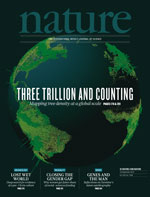 A 2011 letter to Nature from Harvard researchers received its second correction today, this time after discovering the researchers conducted experiments in which mice may have “experienced more pain and suffering than originally allowed for.”
A 2011 letter to Nature from Harvard researchers received its second correction today, this time after discovering the researchers conducted experiments in which mice may have “experienced more pain and suffering than originally allowed for.”
That quote comes from an accompanying editorial in the journal, a rare move for a correction to a 2011 letter. But it’s an unusual correction, for a letter that found that a component of a pepper plant appeared to selectively kill cancer cells, leaving healthy cells relatively unscathed.
Here’s the first paragraph from the detailed correction notice, published today:
In this Letter, we presented findings from experiments using the EJ bladder xenograft cancer model, in which some tumours on some of the animals exceeded the maximum size (15 mm in any dimension) permitted by the Institutional Animal Care and Use Committee (IACUC) at Massachusetts General Hospital (MGH). Therefore, we withdraw the data presented in Supplementary Fig. 9b, as well as in Fig. 2 from the first Corrigendum. Although other tumours were found to exceed the permitted maximum, owing to the degree of tumour size and the circumstances of the experimental procedures, this was considered acceptable as detailed below.
It was the larger size of the tumors that may have caused the animals distress, the editorial notes:
In this case, prompted by a complaint from a reader and following consultation with the authors and the relevant bodies, Nature has established that the scientists did not carry out the required monitoring properly. As a result, some of the tumours grew larger than permitted. These mice could therefore have experienced more pain and suffering than originally allowed for, although it is important to note that they did not show any visible signs of distress.
As well as writing to correct their paper to mark the breach of animal welfare guidelines, the authors apologize for the breach. They are right to do so. Cases such as this could provoke a justifiable backlash against animal research. All involved — scientists, institutions, funders and journals — must do more to ensure that regulations are strictly observed.
A reader forwarded us his correspondence with Nature editors about this paper, in which he specifically raised concerns about the size and condition of the tumors that are “much larger than is permitted by animal ethics committees” in 2012.
The journal is now beefing up its oversight of such studies:
As a result of this case, we are increasing the amount of information we request from authors. In experiments in which tumours are grown, we now require authors to include the maximal tumour size permitted by the institutional animal-use committee, and to state that this was not exceeded. Authors must also provide the source data for any figures that analyse tumour growth.
But the journal is not retracting the paper, it writes:
The scientific conclusions of the paper remain valid and useful, and still stand.
When asked why it took so long to correct the paper, a Nature spokesperson told us:
For confidentiality reasons, we cannot discuss the details of the editorial history of any Nature paper with anyone other than the authors. We take all issues related to animal welfare and ethical animal research very seriously. If we become aware of any breach of our editorial policies in any published Nature paper, we look into it very carefully.
It’s not the first correction for the letter, which has been cited 311 times, according to Thomson Scientific’s Web of Knowledge — it was updated for the first time less than six months after it was published, in what we can only describe as a “mega-correction.” Although the changes “do not alter the overall conclusions,” they included fixes to the description of their methodology and data measurements, and swapped out one figure.
This also isn’t the first literature update for last author Sam W. Lee — he’s had two papers retracted (including one pulled earlier this month) and one other mega-correction.
We’ve contacted corresponding authors Lee and Anna Mandinova, and will update the post if we hear back.
Update 9/16/15 8:17 p.m. eastern: David Vaux — a member of the board of directors of the Center for Scientific Integrity, our parent company, has been corresponding with Nature about this issue since July 2011. He told us:
Some of the tumours were 7 cubic centimeters in size, far, far in excess of the permitted ~1.5 cubic centimeters. In addition, the dark patches are ulcerating tumors. Mice with ulcerating tumors must be euthanised immediately. From the recent Editorial and second correction, you get the impression this was a minor technical breach, rather than a flagrant, gross breach, which it was. I asked them then to retract the paper and publish a strongly worded editorial. Why has it taken so long for Nature to act?
Like Retraction Watch? Consider making a tax-deductible contribution to support our growth. You can also follow us on Twitter, like us on Facebook, add us to your RSS reader, and sign up on our homepage for an email every time there’s a new post. Click here to review our Comments Policy.
Concerns have been raised about this paper at PubPeer for almost a year now:
https://pubpeer.com/publications/21753854
Sam W Lee papers under scruntiny at Pubpeer:
https://pubpeer.com/search?q=sam+lee&sessionid=150AF69451E396FD8FC4&commit=Search+Publications
That should be scrutiny.
Just so there’s no doubt regarding the track record of Sam W Lee in these types of affair…
http://www.psblab.org/wp-content/uploads/2015/09/SWLee.pdf
And of course there are the obligatory astroturfing websites…
http://samwlee.com
http://samwlee.org
http://samwlee.net
Reminds me of the huge tumors shown in the infamous Seralini GMO study…